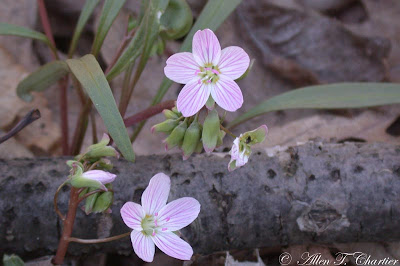Spring wildflowers were in bloom everywhere, and "getting close to the earth" means laying down on your belly in the trail in order to see them well. Skunk Cabbage (Symplocarpus foetidus) is the earliest blooming wildflower around here, often getting covered over with late snowfalls. The patches of large green leaves indicated that most of this species had bloomed weeks ago, but some of the odd flowers of this plant were still in evidence.
Another species that was forming carpets of green in certain areas was Marsh Marigold (Caltha palustris).


On the drier parts of the forest floor, one of the commonest wildflowers was the Rue Anemone (Anemonella thalictroides).

And many of the conspicuous "usual suspects" that are expected in a Michigan woods this time of year were in bloom, including Spring Beauty (Claytonia virginica)...

A number of less conspicuous flowers were also found. Although the purplish stems of Blue Cohosh (Caulophyllum thalictroides) are fairly conspicous, the flowers can be difficult to see unless you look closely.

Although there were leaves everywhere of the Large-flowered Trillium (Trillium grandiflorum), only a few were in bloom.
Even an orchid species was found, though it wasn't in bloom. The striped leaves of the Puttyroot, or Adam and Eve Orchid (Aplectrum hyemale), is very conspicuous in early spring, but will whither before the plant flowers in late May.

A familiar sight in woodlands throughout Michigan this time of year is the Spicebush shrub (Lindera benzoin) with its yellow flowers. Less familiar, because it is somewhat rare, is the Leatherwood shrub (Dirca palustris).

Among the non-flowering species, the Christmas Fern (Polystichum acrostichoides), which stays green all winter, was easily found.
And a couple species of sedge, this one unidentified (I don't do sedges!), were in flower.
Other plants found in the woods today included Spring Cress (Cardamine bulbosa), Field Horsetail (Equisetum arvense), Mayapple (Podophyllum peltatum), Beechdrops (Epifagus virginiana,seed pod only), Wood Strawberry (Fragaria vecsa), and Harbinger-of-spring (Erigenia bulbosa).
Insects were very much in evidence, not the least of which was the cloud of gnats that seemed to be everywhere I wanted to go. No biting insects were out, however. Among the butterflies seen were Mouning Cloak (Nymphalis antiopa), Cabbage White (Pieris rapae), Eastern Comma (Polygonia comma), and Spring Azure (Celastrina ladon). A couple of Green Darners (Anax junius) were the only dragonflies seen.
There was much activity around the blooming flowers, many pollinators getting some of their first feedings of the spring. But few honeybees (Apis mellifera) were out, only a few Carpenter Bees (Xylocopa virginica). The main pollinator seemed to be the Large Bee Flies (Bombylius major). Here is one on a Bloodroot flower.
Brown Click Beetles (Melanotus sp.) were out doing whatever it is they do.
And this tiny jumping spider was hunting the leaf litter. I believe it is Pelegrina proterva.
Reptiles and amphibians emerge in the spring as well, and in addition to a fleeting look at a Common Garter Snake (Thamnophis sirtalis), I managed a photo of this Northern Ribbon Snake (Thamnophis sauritus septentrionalis). A Painted Turtle (Chrysemys picta) was sunning in the river.
Frogs and toads were heard calling, including Western Chorus Frog (Pseudacris triseriata), Eastern Gray Treefrog (Hyla versicolor), and American Toads (Bufo americanus). At the breeding pond where Spotted Salamanders (Ambystoma maculatum) can be found, I had no luck, but at other places in the woods I did see a few Red-backed Salamanders (Plethodon cinereus). Due to the warm temperatures - it was approaching 70 degrees - most of them were much more active than they usually are on cool damp mornings, so I managed but one photo of a single individual of the "lead-backed" color morph.

And of course, there were the birds. Thirty-one species were either seen or heard. One of my favorites of the day was the Louisiana Waterthrush (Seiurus motacilla) whose song rang throughout the woods during most of the morning.

Once I located the singer and took a few photos, for nearly an hour I enjoyed its beautiful song, in this beautiful woods, on this beautiful planet.


















2 comments:
Allan, many thanks for sharing the beauty and diversity of the Nan Weston preserve.
It's truly a biodiversity hot spot - one of the best in Michigan!
Mark,
I agree! I also have a soft spot for the Waterloo SRA, and the Port Huron SGA.
Post a Comment